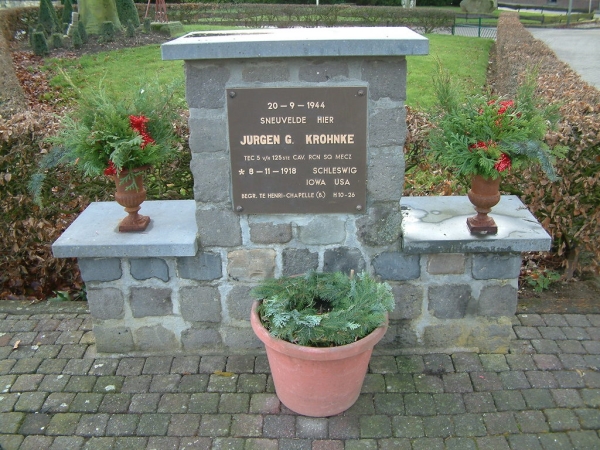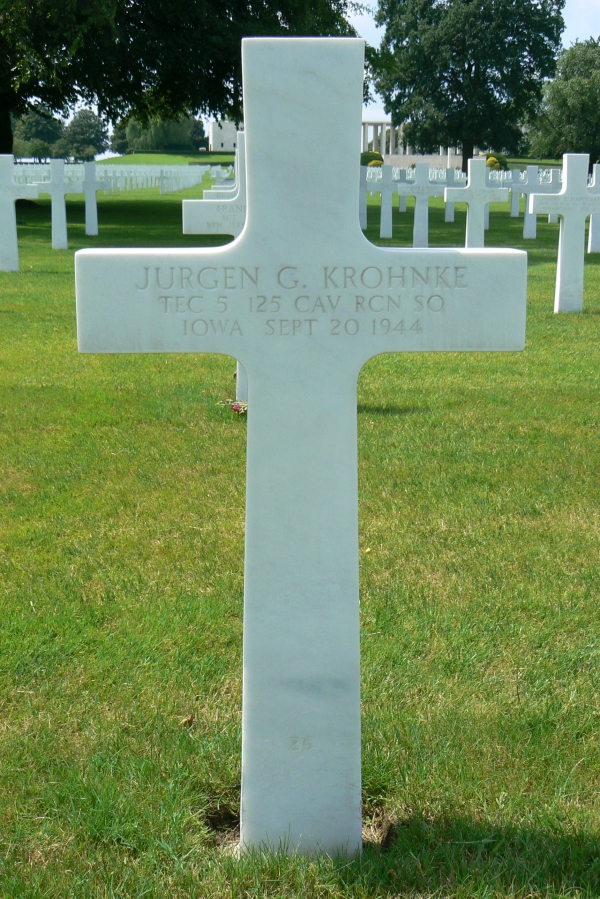
In September 1944, for many people in southern Limburg, the long-awaited liberation was imminent. One by one the small villages were liberated by allied soldiers. Some of those villages were rid of their occupier with little effort, for others, days of bitter fighting were needed. The most common image after the end of the battle: German soldiers fleeing eastwards, pursued at a relatively short distance by American soldiers and cheerful locals.
In the late afternoon of 16 September 1944 roomers were spreading through Bocholtz: The Americans are coming! Although the liberation of this village was only scheduled for the days to come, some Dutch civilians took their chance. Celebrations erupted in the streets. Some people even had the guts to fly illegal Dutch flags. Some German soldiers riding through town by bicycle, got so scared by this sight, that they turned around and rode straight back into Germany.
Between 17 and 19 September, the time had come. Although they only met little resistance within the town, the American troops had to proceed with great caution. During their advance they killed 14 enemy soldiers, something the townspeople didn’t really like. The victims were all Austrian men, aged 55 to 60. They had all been forced to join the ‘Volkssturm’. The 14 soldiers had always maintained a good relationship with the locals.
On 20 September, parts of the US 113th Cavalry Regiment ‘Red Horse’, supported by troops of the 30th Infantry Division ‘Old Hickory’, had advanced towards the eastern extremity of Bocholtz. They found themselves about halfway between the village and the German border. The mission of these troops from here was to head north and liberate the rest of Limburg. They were not yet allowed to cross the border into Germany.
Along the border there was the Westwall, a German defensive line, existing of bunkers and anti-tank barricades, stretching from the river Rhine in the north to the Swiss border in the south. With the allies it was better known as ‚Siegfried Line‘.
The German troops manning the Westwall were aware of the allied advance towards their position, but they were convinced that the Americans would attack their line. Therefore they had started to regularly fire artillery round towards Bocholtz a few weeks before the Americans came, killing 8 civilians.
The Americans were determined to end the constant threath of the German artillery. After they had reached the eastern side of the village, the heavy tanks were ordered to open fire on the German artillery. The Germans, thinking the attack on their Westwall had started, responded with an all-out artillery barrage on the American position. A hail of artillery shells hit the unexpecting American troops, who scrambled to find cover.
When the first shells came in, Jürgen Krohnke stood next to the light armoured vehicle he was the driver of. He tried to get into his driving position. When he was on top of the vehicle, he got hit in the face and neck by shrapnel. Despite the attempts to rescue him, Krohnke died even before he could be taken to a hospital.
As his name reveals, Jürgen G. Krohnke had German ancestors. Their roots were in the duchy of Schleswig, in northern Germany. In the difficult years after WWI, the entire family left the war-stricken Germany and moved to the United States. They started a new life in Schleswig, Iowa, a small town named after their former home-country. Although the monument states that Jürgen was born in the US, this is not certain. Even his parents knew for sure that their son had been born in Germany, only weeks before they had left.
Jürgen G. Krohnke was in 125th Cavalry Reconnaissance Squadron, Mechanized, part of the 113th division. He held the rank of Technician 5th Class. When he was killed, Krohnke was 25 years old. In under 2 months he would have become 26. He was buried in Henri-Chapelle and posthumously awarded a Purple Heart.

Jürgen Krohnke's grave
This cache is part of a series. The caches are:
'40-'45: Kapelaan Berix (GC2PEZJ) (in English) '40-'45: Veer Berg-Meeswijk (GC2PEXA) (in English) '40-'45: Brug Obbicht (GC2PER6) (in English) '40-'45: Sluis Born (GC2PEP0) (in English) ’40-’45: Brug Roosteren (GC2TV5X) (in English) '40-'45: Sittard War Cemetery (GC2TV9R) (in English) '40-'45: Staff Sergeant Booher (GC2TQC1) (in English) '40-'45: Jürgen G. Krohnke (GC2X5V3) '40-'45: RCAF Bomber Crew (GC2X60A) (in English) '40-'45: Schepenkerkhof (GC2X6KF) (in English)All caches contain a bonus number. When you find all 10 of them, you can search for the bonus cache (GC2X6MV).
Did you find one or more caches in the series before there were bonus numbers added? Send me a message,telling which caches you’ve found and on which date. I will try to send you the bonus numbers as soon as possible!
Geen opmerkingen:
Een reactie posten